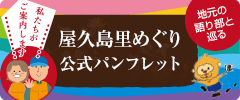nakama
The God of Childbirth
- Modification: 2024/01/10
- Area: nakama
Once upon a time, you might have chanced upon a plethora of sixty-centimetre-plus black stones set at the roots of this large tree.
For much of history, childbirth was an event wrought with life-threatening danger. As such, we can find many a childbirth-oriented shrine here on Yakushima.
As for Nakama’s god of childbirth—well, it is said that the black stones at the base of this tree would replicate themselves, increasing in number by one stone, each and every year. Until about 1948 (Shōwa 23), adolescent boys in the village used to grow flowers at this site. People would pray casually as they passed, but also when there was the flu or another bug going around, or before and after childbirth.
While the once abundant large black stones and their small pebble progeny are no longer here, the spirit of rest, rejuvenation, and well-wishes for the health and wellbeing of one’s family still remain at the foot of this tree.
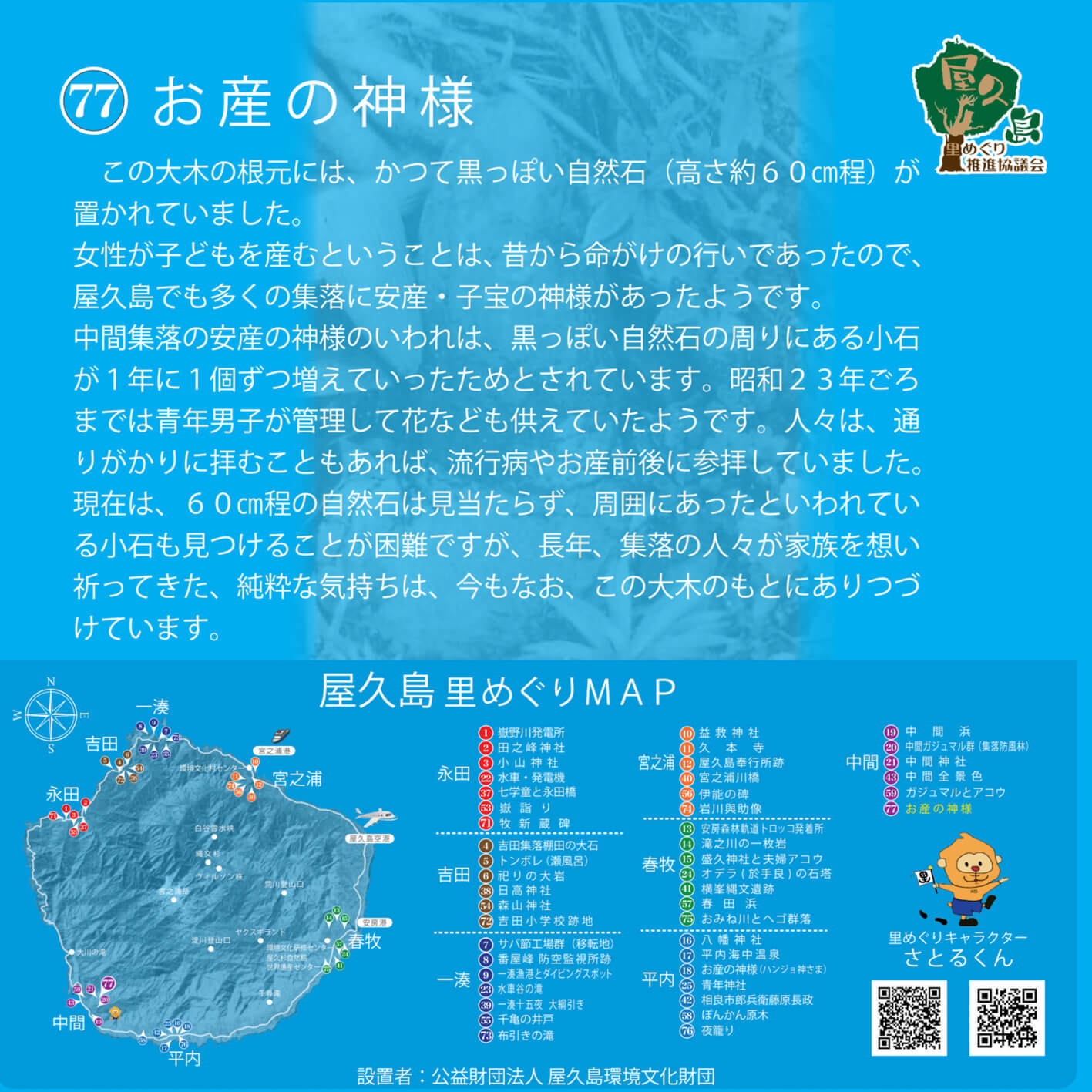
Banyan and Sea Fig
- Modification: 2023/12/22
- Area: nakama
Acting as a natural windbreak against the strong coastal winds of the area, many a banyan (any number of species under the Ficus sub-genus of Urostigma) and sea fig (Ficus superba var. japonica) tree can be found around Nakama Village.
Within the village, too, are these special trees—typified by the beloved banyan arch that is comprised of a 300-year old banyan on the left and a younger sea fig on the right (when viewed from the bridge).
Upriver from this spot at a distance of approximately 30 meters is another gigantic multi-tree symbiote, again comprised of sea fig and banyan. The grounds of Nakama shrine also feature a prominent banyan tree for your dendrological viewing pleasure.
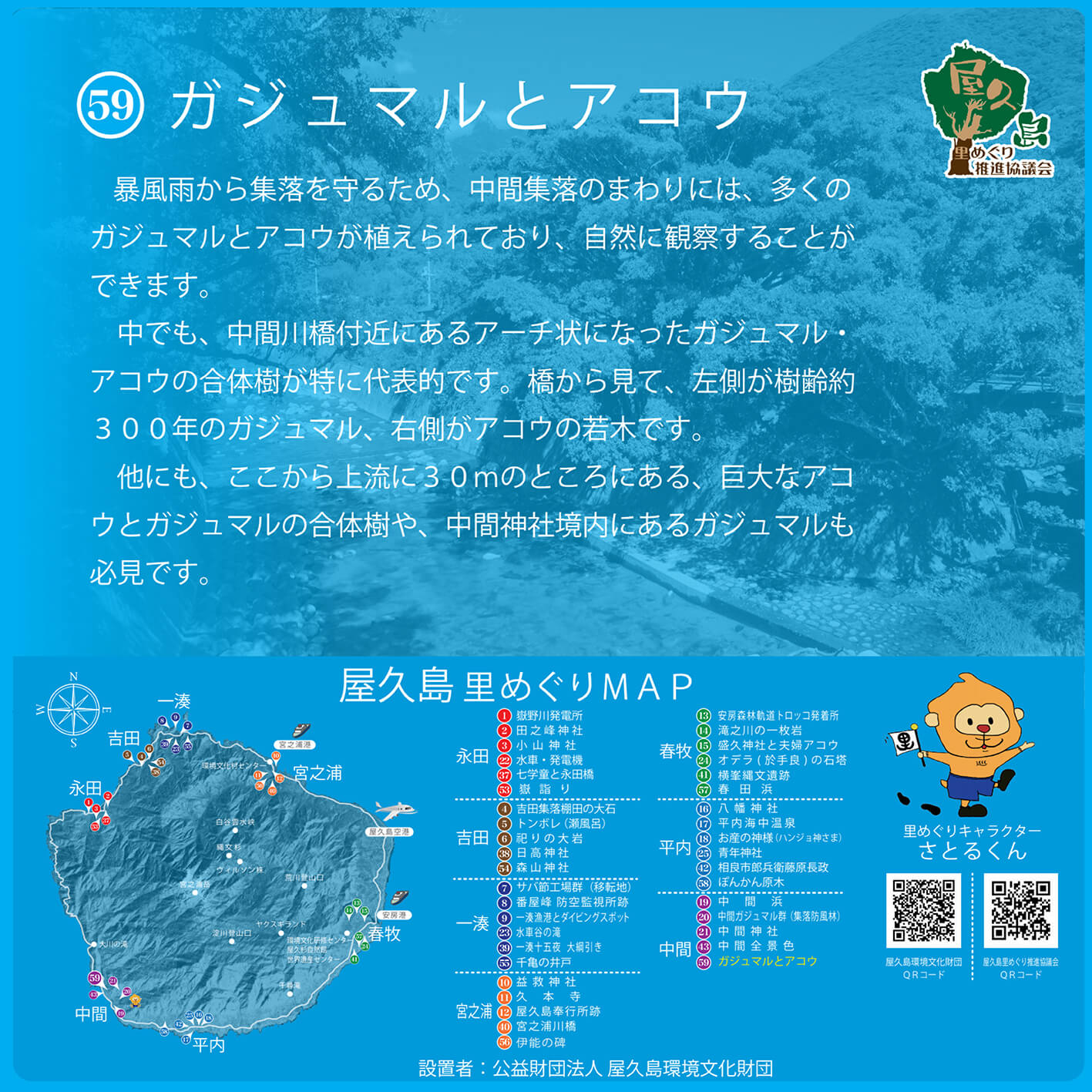
Nakama Banyan Grove
- Modification: 2023/12/22
- Area: nakama
This gigantic banyan tree, which acts as a natural windbreak to the village, is over 300 years old and has been designated as part of Yakushima’s Cultural Heritage. Banyan trees here are also known as “octopus trees” as per their physiology, which is characterised by aerial roots sent down by the tree to the ground, which form the huge and gnarled-looking trunk.
Beyond this arched gate once stood a factory that processed sugar cane, as well as a power-generating water wheel at the river. It is said that if you pass under this banyan arch, you will be the recipient of good fortune—thus, it came to be known as the “lucky banyan gate”.
The Nakama River (also known as the Great River), is large amongst Yakushima’s bodies of water, and has allowed for the lives and livelihoods of the village residents since ancient times. On its opposite shore, there stand several large ficus and banyan, one of which is a large multi-tree composite banyan.
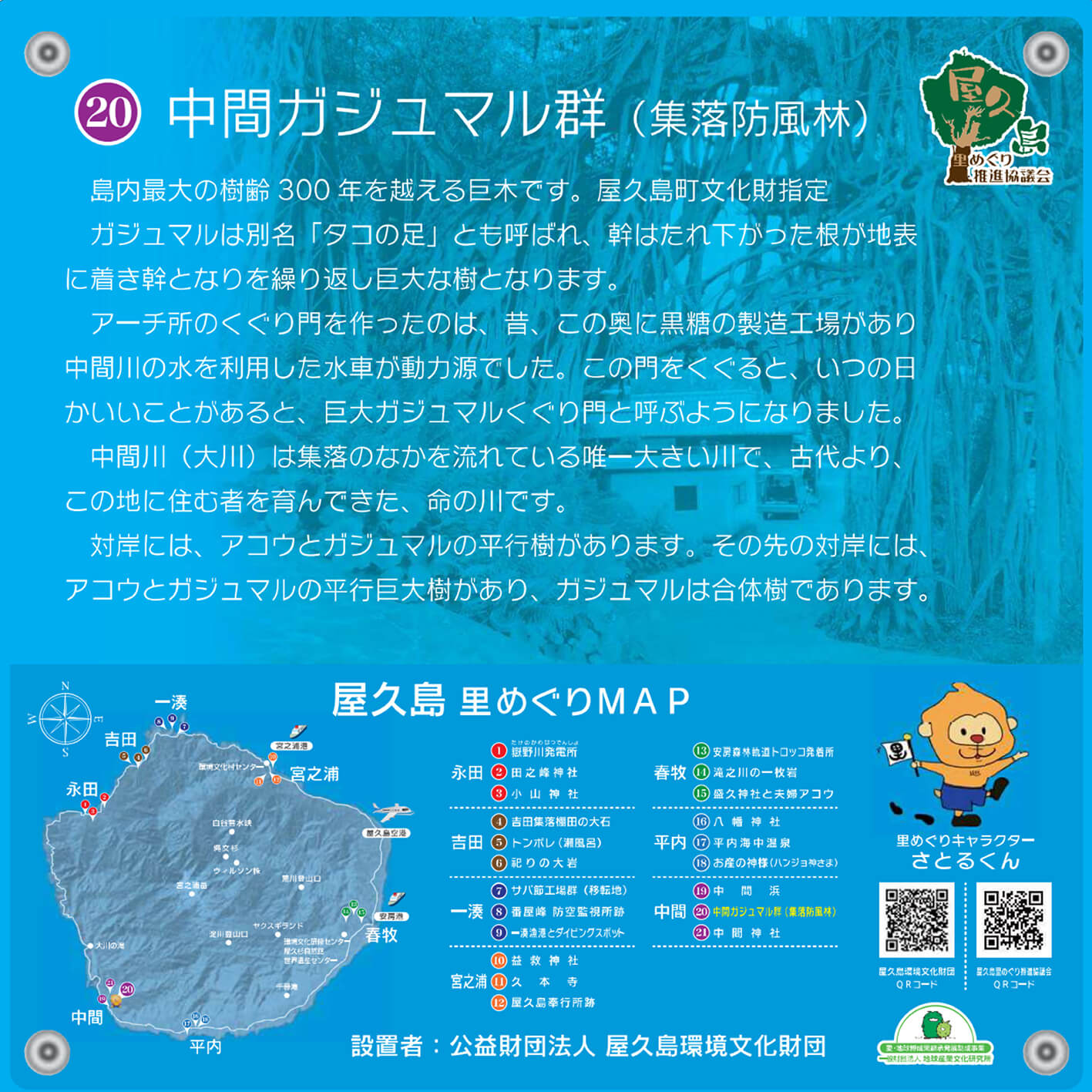
Nakama Satomeguri Map
- Modification: 2023/12/22
- Area: nakama
森山大明神 Moriyama Daimyōjin
A small, history-laden stone shrine donated by a private individual in 1827 (Bunsei 10).
炭窯 Sumigama (charcoal kiln)
The last remaining kiln on Yakushima that was used for producing high-quality charcoal.
中間神社 Nakama Shrine
The path leading to the shrine was made using old, natural stones leftover from bygone days. Each year, the shrine holds a welcoming banquet for those returning from Takemairi, or the mountain pilgrimage.
公民館 Community Center
The launching point for Nakama’s Satomeguri local tour. Rest your frantic heart, traveller, for here lies a public toilet.
中間ガジュマル Nakama Banyan
The symbol of Nakama: a 300 year-old banyan tree that has grown into the shape of an arch!
Once the location of an NHK drama.
七五岳 Mt. Shichigo
A 1488m sacred mountain, shrouded in legends of villagers being spirited away without a trace.
It’s visited every year on the tenth day of the ninth month of the traditional Japanese lunisolar calendar, the day of the takemairi mountain pilgrimage.
泉念の水 Sennen no Mizu (Wellspring of Wonder)
A spring of refreshing water—the perfect rest stop during a walk around the village.
中間フルーツガーデン Nakama Fruit Garden
A garden home to about 1,700 types of tropical plant species. Enjoy a taste of tropical fruits here! Entrance fee: 500 yen for adults, 250 yen for children. Open from 8am – 5pm every single day. Telephone: 0997-48-2468
日高鮮魚店 Hidaka Fish Monger
Get your fresh fish and your daily necessities here, y’all!
Hot-and-crispy-from-the-fryer oysters are a local masterpiece!
石垣 Stone Wall
Built around 1887 (Meiji 20) by stonemason Shimizu Itarō.
Together with the cobblestone road, it adds a tropical touch to the village.
海ガメ孵化場 Sea Turtle Hatchery
A hatchery used to ensure the safe hatching of sea turtle eggs that have been laid on Nakama Beach. See baby sea turtles make their way to the ocean every year around the time of the summer festival.
亀石 Turtle Rock
A large boulder that resembles the shell of a turtle.
中間バス停 Nakama Bus Stop
A local transport waiting spot. Be sure to check out the handmade styrofoam chair!
中間浜 Nakama Beach
A surfing spot with a seldom-seen-on-Yakushima sandy beach. From here, you can enjoy spectacular views of Kuchinoerabu Island, the Tokara Islands, and beautiful sunsets.
墓地 Graveyard
The local resting place for Nakama residents, always adorned with vibrant and beautiful flowers.
大黒天 Daikokuten
There are a total of seven statues of Daikokuten on Yakushima. He is one of the seven gods of fortune, presiding over the realms of treasure and happy prosperity.
中間川 The Nakama River
A beautiful river running right through the village, adorned with the wooden and emotive Nakama Bridge.
エビス様 Ebisu-Sama
A wooden statue of Ebisu, a god of fortune often patronised by fisherpeople and seaside communities. Every year on May 2nd, there is an Ebisu Festival held here.
農業公園ファームパラダイス “Farm Paradise” Agricultural Park
A farm specialising in the organic cultivation of tropical fruits, such as guava. Fresh fruits are available for purchase at the storefront. Entrance fee: 200 yen.
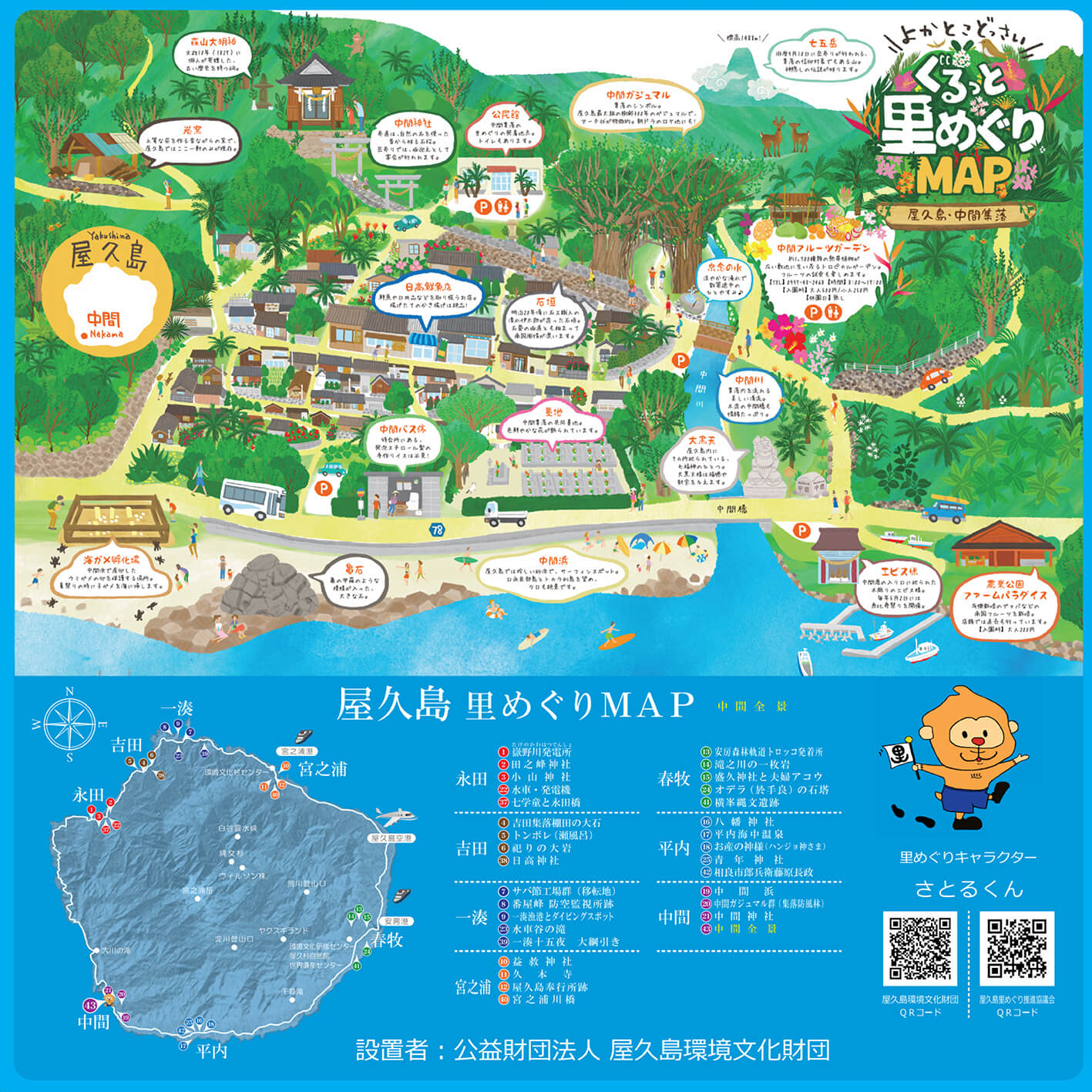
〒891-4205
鹿児島県熊毛郡屋久島町宮之浦823番地1
TEL:0997-42-2900
FAX:0997-49-1018
(屋久島環境文化村センター内)






